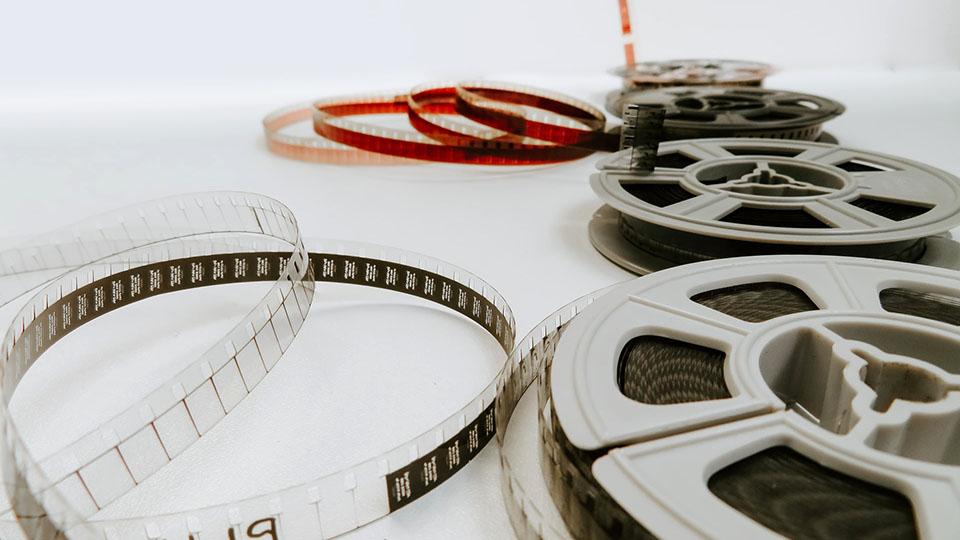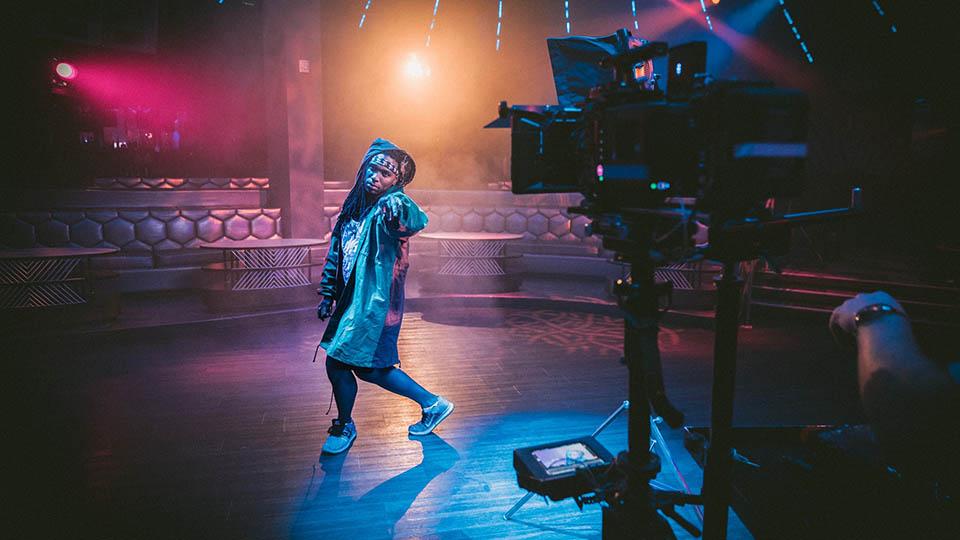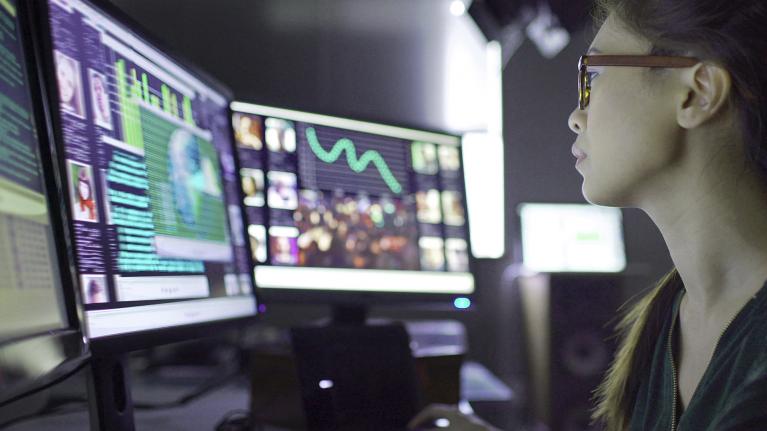
British music video: assessing industry, influence and impact 1966-2016
Introduction
In 2015, an Arts and Humanities Research Council award was made to a team of researchers led by Professor Emily Caston and Professor Justin Smith to examine the history of British music video since the 1960s.
It drew on Emily Caston's expertise as a senior and award-winning music video producer who has worked with acclaimed directors Spike Jonze and Chris Cunningham and artists including Madonna, Bjork, Oasis, The Chemical Brothers and U2. The research was conducted at the University of West London, the University of Portsmouth, the University of the Arts London, and De Montfort University.
The objective of the research project has been to generate a range of new collections and outputs enabling further research in this relatively new field of study, as well as a number of initial theoretical and evidence-based publications establishing the significance of this neglected field for film and television studies, popular music studies and cultural studies.
The research project also aimed to help protect and conserve important landmark visual works which were at risk of being damaged or lost to history and to bring these works into the public domain.
This mammoth collection of pop videos is as close as we get to establishing a canon for the art form.
Research Impact
- In order to stimulate and enable further research, we have created a new digital collection of music videos commissioned by Warp Records to accompany the existing collection of their audio recordings at the British Library Sound Archives.
Warp records constituted an important case study for the research because of its pioneering role in commissioning and distributing innovative music videos from the 1990s onwards. Research assistant Mimi Haddon analysed the significance of Warp Records and its industry offshoot Warp Films in her article in our first Journal Special Issue for the collection.
- We have also made public a donation from Video Performance Ltd of its record of all music videos issued a licence in the UK for broadcast since their records began. This serves as a basis for researchers to appreciate the size and scale of music video broadcasting in Britain. This database is held at both the British Library and the British Film Institute.
- We are, in the process of preparing a collection of 100 Landmark Music Videos for the British Film Institute National Archive. The research team has catalogued the videos so they will be accessible to the general public, students and academics for research.
- We are in the process of producing a detailed set of programme notes for each video, documenting the rationale for each video’s inclusion, the video’s production and broadcast history, as well as excerpts from interviews with the filmmakers.
Key quotes on the significance and achievements of the project
Exploring the history and influence of British music video
Professor Emily Caston’s work archives the importance and influence of British music video and is some of the first research of its kind to be carried out in the UK.
-
Tony Kearns – BAFTA nominated film and television editor
"Gathering the information and the history about the people and how these music videos happened in recording history has never been done; I’m delighted that this is happening. Putting together this data so that the information can be accessed and understood will really help the recognition of music videos. Everyone says it’s a transitory business. None of us were thinking about what would happen to the work we were doing. But now, looking back, we can see that something was going on that was interesting, that was singular. We didn’t bother to save our video masters or callsheets because we were just like, ‘next video, next job, deliver that, do that’ - we were too caught up with it. But looking back with hindsight now, you can see we ought to have kept a record because it was a really important period. Without you (Caston) interviewing us and writing that history there would be no record for people to read and understand."
-
Heather Stewart, Creative Director Programme, British Film Institute
The research project has highlighted “this important British screen production sector which had previously received little attention at a policy level despite its international reputation for creativity and innovation. The box set curated, copyright cleared and produced by the project, of the most significant British music videos stands as a significant educational resource for use in film and television studies in schools and universities. The deposit of these productions in the Archive together with all relevant metadata added to the BFI’s Film and Television Database has been a major benefit to the BFI. A second impact of the research has been the acceptance of this part of Britain’s screen industries as both a significant contributor to the UK’s international success in moving image production playing an important role in aesthetic innovation and as nursery slopes for directors and producers who have subsequently had huge international success in the film industry.”
-
Music video directors Dom & Nic
"The project prompted us to digitally update our own archive and as a result it is now safely stored in the original broadcast quality for the future. Despite originally being shot on film the vast majority of music video from the period covered by the project were mastered on videotape. This format has become outdated and obsolete and is prone to deterioration. The archive being made on DVD and the digital masters used to make the DVD now function as an important archive of much work that may well have eventually been completely lost."
Background
The first stage of the research was to identify 200 landmark music videos produced in Britain between the years 1966 and 2016 from a long list of approximately one thousand titles.
This was done in consultation with a panel of directors, producers and video commissioners in a series of focus groups held at the British Library, British Film Institute and British Universities Film and Video Council. Panellists included filmmakers Aoife McArdle, Jake Nava, Dougal Wilson, Dawn Shadforth, Fran Broadhurst, Tony Kearns, Max & Dania, John Stewart, Cynthia Lole, Mike O’Keefe, Carrie Sutton, Dougal Wilson, John Hassay, Liz Kessler and WIZ.
The next step was to locate digital copies of these landmark videos and production credits. A number of videos survived only in the form of original film prints. These, such as Manfred Mann's Mighty Quinn, were digitised by the BFI and graded by Tareq Kubaisi at Raised By Wolves.
The research team then undertook two years of research to identify production credits for the videos using social media and interviews to build up a picture of the industrial structure of companies involved in their production – record labels, production companies, post-production houses and freelance crew.
In Year 2, the research team addressed a series of deeper theoretical questions about the concept of ‘authorship’ in music videos, the editor's role, and the history and significance of dance in British music videos. These were investigated in a series of focus groups held at the British Film Institute with leading practitioners such as acclaimed choreographer Arlene Phillips.
They were explored further in semi-structured interviews with the filmmakers conducted by the research team in London and Los Angeles, where a significant number of British directors have made careers. The results of these interviews and focus groups were used to compile individual programme notes on each video for the BFI National Film Archive.
In Year 3, attention focused on the over-arching questions of this project concerning the impact and influence of British music videos both within the UK and internationally.
The first task was to identify and analyse the sector’s industrial history. This has involved not only appraising the sector’s intersections with the film and television industries but also the changing structures of the music industry.
It has involved interviewing over fifty commissioners, directors, producers, cinematographers, editors, colourists, managers and artists from across the fifty years of this study. The results of these interviews will form the basis of two forthcoming books by Emily Caston.
The researchers
- Professor Emily Caston
- Professor Justin Smith
- Dr Mimi Haddon
- Liz Kessler
- Jennifer Roberts
-
The steering committee for the project
The steering committee for the project included:
- Rob Dickens C.B.E. (MD Warner Music 1974-1983, Chairman of Warner Music 1983-1988, Chair of BPI 1986-1988)
- Mike O’Keefe (Vice-President of Sony Music UK)
- John Stewart (MD The Oil Factory 1987-2004)
- Dylan Cave (Curator, BFI National Film Archive)
- Andy Linehan (Curator, Popular Music at the British Library)
- Professor Richard Paterson (Head of Research & Scholarship at the BFI)
- Professor Keith Negus (Goldsmiths)
- Professor Kevin Donnelly (University of Southampton)
- Marketa Uhlirova (Central St. Martins UAL)
- Dave Laing (University of Liverpool)
- Dr Paula Hearsum (University of Brighton)
- Dr Holly Rogers (Goldsmiths)
- Dr Diane Railton (Teeside University).
-
The PhD Students
- Mike Exarchos – Re-imagining the phonographic in sample-based Hip Hop: making records within records – supervisor Justin Paterson
- Charlie Norton – Strategies for improving the bidirectional relationship of expressivity between electronic musicians and complex sound-generating systems – supervisor Justin Paterson
- Lesley Anne Knight – A way with words. The art of negotiation and collaboration in the age of the ‘New Woman’ on Broadway as seen through the careers of Anne Caldwell, Dorothy Donnelly and Rida Johnson Young, 1906-1928 – supervisor David Osbon
- Jennifer Ansari – Real-time Interactive Technology within distributed creativity in string quartet performance – supervisor David Osbon.
Our Partners
The research project has represented an important collaboration between Universities, The British Library, The British Film Institute, Warp Records and Thunderbird Releasing.
British music videos have been highly influential internationally but are rarely recognised as part of Britain's national screen heritage or moving image art.
The project's primary aim was to understand and document the acclaimed and innovative work of the British music video industry from its origins in the 1960s through to the MTV and YouTube eras.
A self-explanatory but pretty special omnibus of the modern art form, rescuing the best clips of everyone from the Cure to FKA twigs from the low-res wilds of YouTube.
-
British Film institute
-
British Library
-
Warp Records
-
The British Film Institute
The project was run in collaboration with the BFI, lead by Professor Richard Paterson Head of Research and Scholarship, alongside Dylan Cave in the National Film Archive. The BFI’s role in the research was to support the curation of a national collection of landmark British music videos. The masters of this collection are held at the BFI National Film Archive in Berkhamstead. An important goal of the research was to identify the original production credits of the individuals and companies involved, and this was achieved. The BFI also provided viewing copies and metadata for the British music video show, The Chart Show (1986-1998) which formed the case study for Smith’s evaluation of European video distribution.
View the BFI website for a record of the project collaboration.
The BFI has since held a number of public events on music video including the 2018 Experimenta event on the Human League’s ‘Don’t You Want Me’ music video (1981) directed by Steve Barron centred on a panel discussion with Professor Caston.
-
The British Library
The project was run in collaboration with the British Library and the Curator for Popular, Music Andy Linehan. With an existing music video collection donated by the Musicians’ Union, and one of the world’s most important collection of popular music audio recordings and associated archives, the British Library was a key partner in the research. The BL acquired the comprehensive database of music videos collated using data donated by the British Phonograph Industry’s Video Performance Licensing, and a catalogue of music videos donated by Warp Records to accompany the BL’s prior collection of Warp Records music and audio recordings.
-
Warp Records
WARP Records were a partner in the research and served as a crucial case study for the analysis of innovation in the British music video industry. The Warp Records label emerged out of the early electronic/dance music scene in Sheffield, UK in 1989, and has since become one of the UK’s most critically acclaimed independent music labels, boasting electronic/dance music artists such as Aphex Twin, Squarepusher, Autechre, and Broadcast at the core of its catalogue. The music videos Warp commissions are highly regarded, particularly those from the mid-to late-1990s, the so-called ‘golden age’ of the British music video. Directors such as Chris Cunningham, David Slade, Alex Rutterford, and Jarvis Cocker are amongst the most well-known names associated with Warp’s videos from that time, and Cunningham’s videos for the Aphex Twin tracks ‘Come to Daddy’ (1997) and ‘Windowlicker’ (1999) are perhaps the label’s most famous. Warp is an exceptional case in the history of British music video since, unlike other labels, it released a DVD (2004) of music videos under its own name, rather than by artists or directors.
Further information
To ensure that our digital collections are not limited in use to people with access to London and Berkhamsted, where the BFI and British Library collections will be held, we have partnered with Thunderbird Releasing to create a digital collection that can be used across the UK for teaching and research.
The Special Edition DVD boxset, released in March 2018, contains Six Discs of videos curated by Professor Caston in genres and themes, along with a booklet containing an introductory essay and production credits for the 200 videos.
It has been designed as a teaching tool for HE and FE courses related to music video within film and television studies, popular music studies and cultural studies.
Power to the People: British Music Videos 1966-2016
Thunderbird Releasing, 5 March 2018
900 minutes, 6 discs, Certificate 18, Region 2, PAL
ASIN: B077YDJVN6
Music Sound and the Moving Image: Special Issue on Music Video, 2017
This contains articles by Emily Caston on dance and choreography in British music videos, Justin Smith on the dedicated music video programme The Chart Show, Dylan Cave on curating music videos at the BFI National Archive, William Fowlers on music video and artists’ film and video, and an excerpt from the editing focus group.
The Journal of British Cinema and Television: Special Issue on Music Video, forthcoming 2019
This will contain articles by Emily Caston on the Impact and Influence of Music Video on the wider British Screen Industries, Justin Smith on Music Videos in the 1960s and Mimi Haddon on Warp Records.
The results of the research project are being written up in two books and two journal special issues:
- Emily Caston (forthcoming, 2019) Art, Authenticity and Authorship in Music Videos. Edinburgh University Press.
- Emily Caston (forthcoming, 2020), Nothing Compares: The Untold History of British Music Video Production 1966 to 2016. Ashgate / Routledge.
Find out more
-
Research Centres
Find out about our multi-disciplinary areas of expertise, research, and teaching.
-
Research impact
Learn how our research has helped communities locally, nationally and internationally.
-
Research degrees
Find out more about PhD and Professional Doctorate opportunities and how we will support you within our active and interdisciplinary research community.










